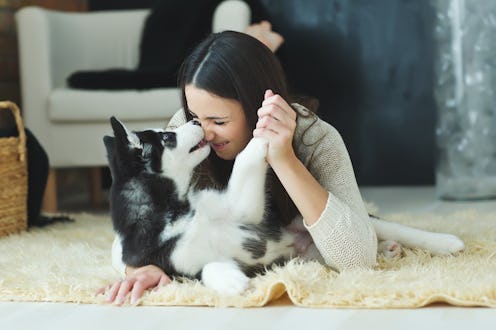Life
Here's How To Get Your Dog To Stop Jumping On People, According To Experts

If your dog always goes into a leaping frenzy when greeting people, and it feels really stressful and out of control, then you may want to teach your dog to stop jumping, once and for all. It can take some time, but once she gets the hang out of it, you'll be able to come through the front door without being knocked over. And all your other interactions will likely improve, too.
"It’s useful to train a dog to sit or remain standing instead of jumping up, because many people find jumping dogs to be unpleasant or even scary," Kristi Benson, CTC, certified dog trainer and author of an online course to train jumping dogs, tells Bustle. It's also not great if they jump on small kids, she says, or older folks. And, if your dog has dirty feet, Benson says, "you’ll appreciate the knowledge that your dog will likely remain four-on-the-floor after some training."
That said, the reason dogs jump and try to get closer to your face is entirely understandable. "Jumping up is the species-specific way dogs greet one another, so it’s common for them to jump on us — and other things, like couches and countertops," Joan Hunter Mayer, a certified professional dog trainer and owner of The Inquisitive Canine, tells Bustle. Jumping is natural, and when they do it to people, it's just their way of saying "hey."
"Some people don’t mind it, especially if the dog is on the smaller side," Hunter Mayer says. "However, it’s still best to teach dogs to perform an alternate behavior, since most humans appreciate when dogs behave politely." And that's where a few simple commands can come in handy.
"Training a dog not to jump up is most efficient as a two-step process," Benson says. "First, train your dog using treats to stay sitting, even when things start to get really interesting." Have them sit, then give them a treat. If they stand up, Benson says, don't give them a treat. Do this, and repeat, until it sinks in — which may take some practice.
Once your dog can sit, try moving around or doing a little dance, to see if they'll react. "If they stand up, then they don’t get that treat: just ask them to sit and start again," Benson says. "If your dog stays sitting, give them a treat! Then repeat the exact same silly movement, so your dog can earn another treat. Only make your movements bigger and longer-lasting when you’ve done five in a row with your dog staying seated."
You'll be teaching your dog that, no matter how exciting or interesting a situation is, it's still not cool to jump up. Once they make the connection, "try a new thing: slowly bring the treat down from above the dog’s head," Benson says. "If they jump up for it, snatch the treat away. If they stay sitting, feed them the treat. Do this for at least ten or twenty times a day for a few days before starting to ask your dog to sit when you come in the door… and have a treat ready for that, as well!"
The second way to break this habit is by showing your dog jumping up doesn't get them the attention they want. "So if they jump up on you at the door, leave again for about 30 seconds," Benson says. "We want our dogs putting it together that sitting earns treats and patting, but jumping up earns them nothing… and in fact, makes their favorite human leave!" It's all about making that connection, and learning how to control their excitement.
Over time, your dog will start to catch on that jumping isn't OK, but standing or sitting is. And once you've successful made it through the front door without them jumping, that's when you can greet them and give them love and attention.
"You can teach a dog fairly quickly the behavior you want them to learn," Hunter Mayer says. "However, it takes consistency to maintain the behavior. Practicing a few times a day for only a few minutes can help. But [you'll] need to maintain the skills and practice them in a variety of situations, with different people."
This means practicing when friends come over, while out on walks — basically any situation where your dog might want to jump. And over time, they'll start to realize that not jumping is much better for everyone
This article was originally published on